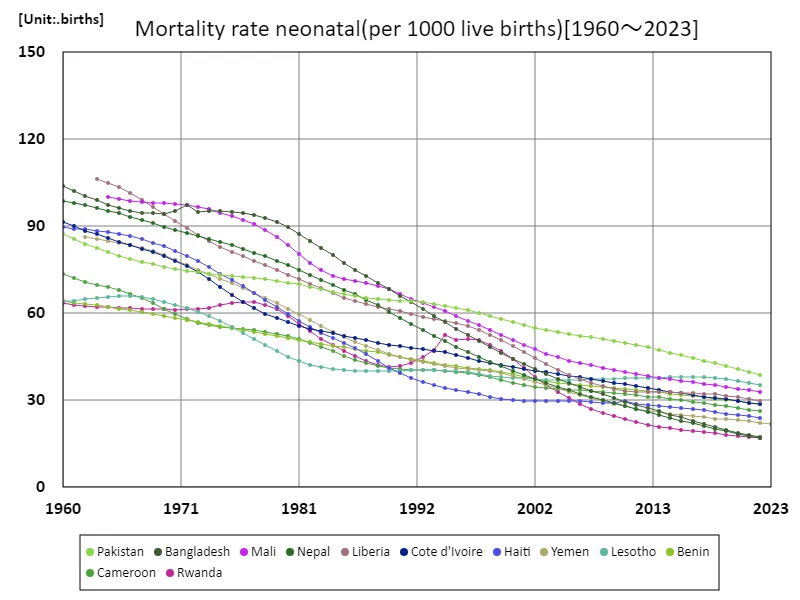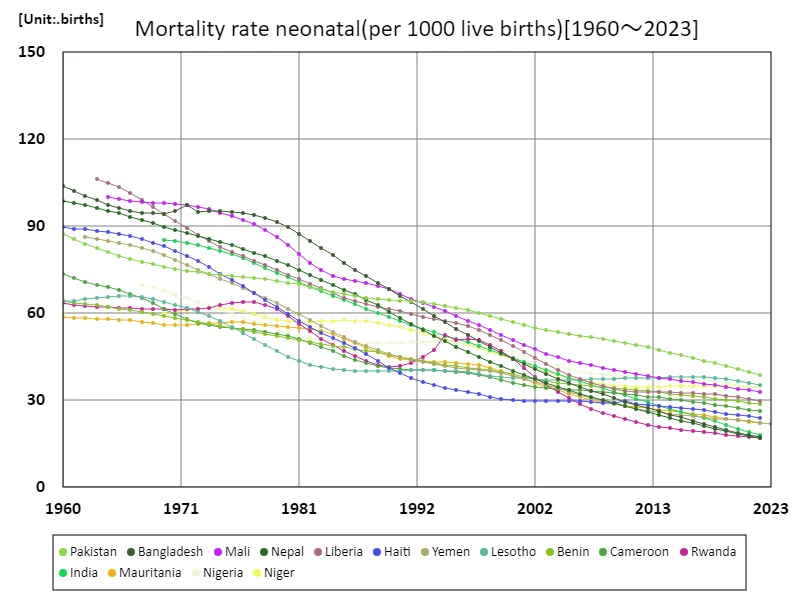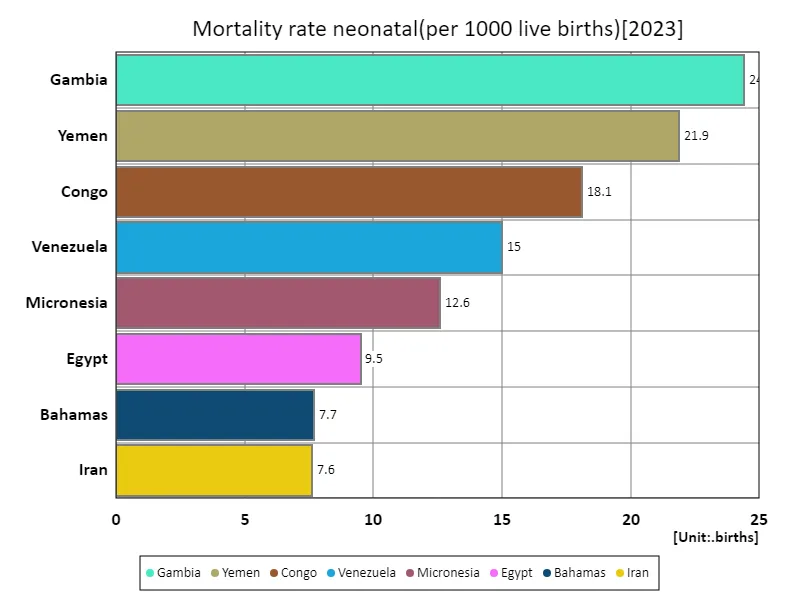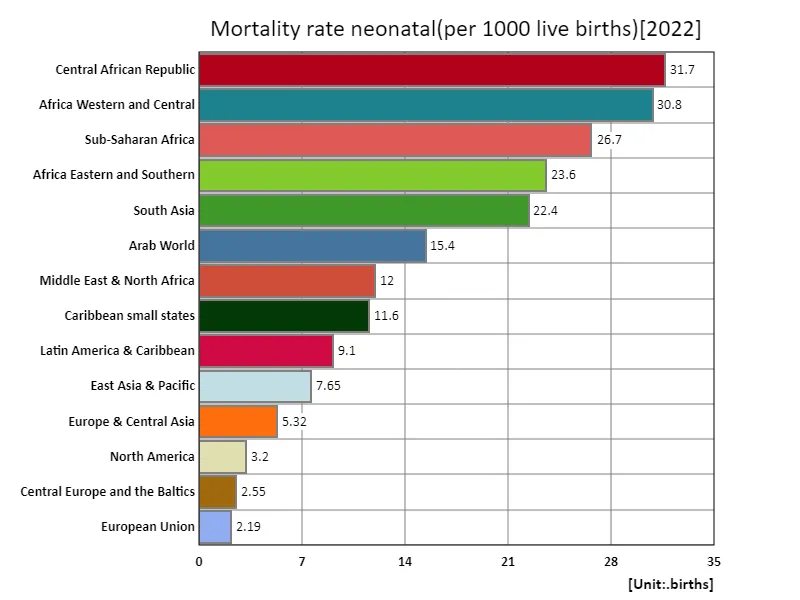Abstract
Neonatal mortality rate is an indicator of whether a baby will survive birth, and is an important indicator of a country’s medical environment and level of social development. Yemen’s high newborn mortality rate of 21.9 in 2023 is due to the long-term civil war, poverty, and lack of access to medical care. In general, countries with high neonatal mortality rates often have lagging behind in improving health and nutritional conditions. In recent years, neonatal mortality rates have been declining worldwide, with many countries seeing improvement thanks to strengthened healthcare systems and widespread vaccination. However, countries facing conflict and economic difficulties, such as Yemen, can slow progress. These trends suggest that sustained interventions and community stabilization could contribute to reducing neonatal mortality.
Neonatal mortality rate (per 1,000 live births)
Looking at the data on neonatal mortality from 1960 to 2023, the fact that a country like Liberia recorded an extreme figure of 106 deaths in 1963 speaks to the immaturity of the medical environment at the time. Liberia’s newborn mortality rate has improved to its current level of 28.1%, thanks to efforts such as improving medical infrastructure, expanding vaccination programs, and improving nutritional conditions. Overall, global neonatal mortality rates have been gradually declining since the 1960s, with many countries seeing improvements in health care and public health progress. However, mortality rates remain high in some countries and progress has been slow, particularly in areas affected by conflict and poverty. This trend suggests that international assistance and sustainable development are key to improving newborn survival.


The maximum is 106births[1963] of Liberia, and the current value is about 28.1%
Neonatal mortality rate (per 1,000 live births) (Worldwide)
Based on data from 1960 to 2023, there is a notable improvement in the evolution of neonatal mortality rates. Liberia’s recorded neonatal mortality rate of 106 in 1963 illustrates the dire health situation at the time. However, Liberia has now managed to reduce that figure to 28.1%. This improvement is due to improvements in medical services, widespread vaccinations, and improved nutritional status. Overall, neonatal mortality rates have been declining steadily since the 1960s. This is due to advances in medical technology, strengthening health systems, and economic development, particularly in developing countries. The decline in neonatal mortality reflects better healthcare and improvements in public health, which have led to improved newborn survival in many countries. However, mortality rates remain high in some regions, and progress has been slow, particularly in areas affected by war, poverty and limited access to health care. Against this background, it is hoped that sustainable development and international assistance will contribute to further reducing neonatal mortality rates.


The maximum is 106births[1963] of Liberia, and the current value is about 28.1%
Neonatal mortality rate (per 1000 live births) (world, latest year)
Data on neonatal mortality in 2023 illustrates global public health progress and challenges. The highest rate was recorded in The Gambia at 24.4, reflecting countries where neonatal mortality remains high. These figures suggest a lack of medical resources and slow progress in improving nutritional and sanitation conditions. In contrast, the global average newborn mortality rate is 13.1, reflecting improvements due to advances in medical technology and widespread vaccination programmes. The total figure of 118 highlights the significance of overall neonatal mortality and its regional variations. Neonatal mortality rates have declined in many countries, due in part to improvements in the quality of medical care, nutrition and maternal and child health, but some countries and regions remain high. In particular, in conflict zones and areas with high levels of poverty, access to medical care is often limited, and progress in improving neonatal mortality rates tends to be slow. Against this background, there is a need for measures tailored to the characteristics of each region and for increased international support.


The maximum is 24.4births of Gambia, the average is 14.6births, and the total is 117births
Neonatal mortality rate (per 1000 live births) (region, latest year)
According to 2022 data, there are significant regional variations in global newborn mortality rates. The Central African Republic recorded the highest neonatal mortality rate of 31.7, which is thought to be due to a lack of medical resources, poor sanitation, and malnutrition. This high mortality rate reflects the current situation in a region affected by conflict and poverty. The overall average neonatal mortality rate was 13.8, reflecting improvements over the past few decades due to advances in medical technology and widespread vaccination programs. However, the total figure of 206 shows that neonatal mortality remains a major challenge worldwide. High mortality rates remain a problem, especially in developing countries and areas with underdeveloped health care systems. The data shows that while improvements in medical care and sanitation have contributed to reducing newborn mortality, there are regional disparities and areas where progress has not been made. International support aligned with the Sustainable Development Goals (SDGs) and tailored responses to local needs will be key to future improvements.


The maximum is 31.7births of Central African Republic, the average is 13.8births, and the total is 206births



Comments